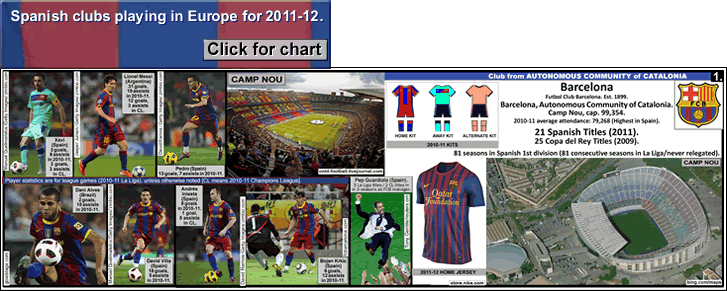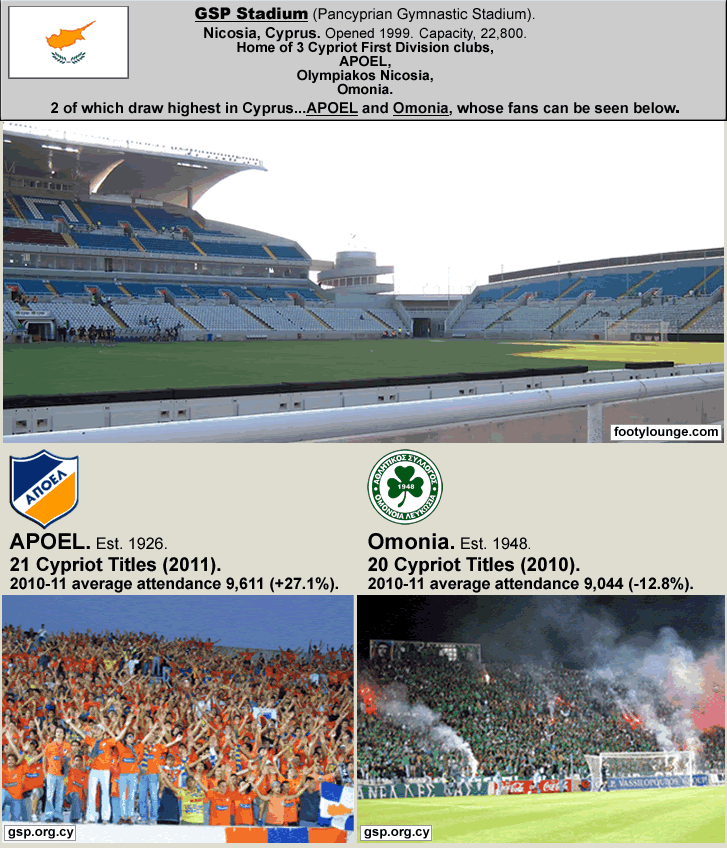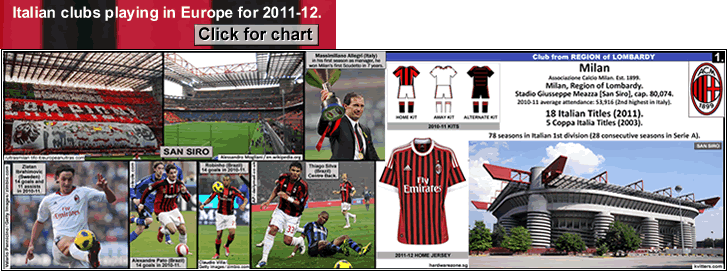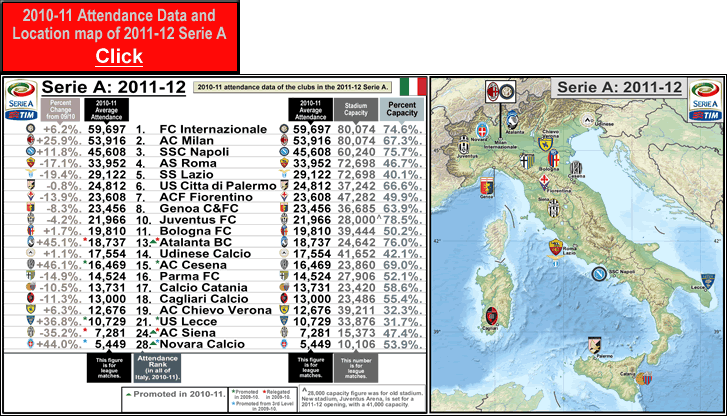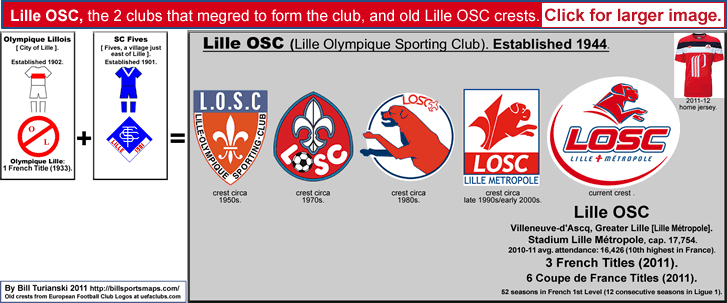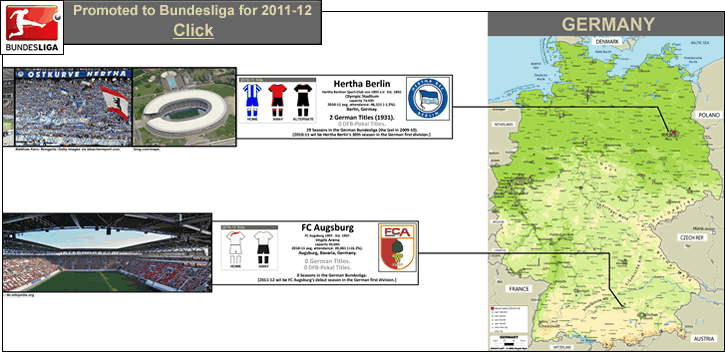
2 clubs promoted to Bundesliga
…
…
Once again, there were just two clubs gaining promotion to Bundesliga, as the Relegation play-off saw 16th-place-finisher Borussia Mönchengladbach defeat the Bundesliga-2 3rd-place-finisher VfL Bochum. Hertha Belin and FC Augsburg were the promoted clubs. For Hertha, it is an immediate return to the top flight; for Augsburg, it will be their first division debut.
Hertha Berliner Sport-Club von 1892 are a pretty large club that, as the largest football club from Berlin, draw in the 45K to 55K range. Hertha Berlin drew 46,131 per game in the second tier last season; 46,681 per game in 09/10 when they were relegated; and in 08/09, when they had a title run that saw them eventually sputter out and finish in 3rd place, they drew 52,157 per game – which was 5th-best-in-Germany that season. What Hertha Berlin can’t do is win a title, and the club is kind of a running joke in the German football scene. They are sort of like the hapless, choking pre-2004 Boston Red Sox (of Major League Baseball), but with an old stadium (Olympic Stadium, capacity 74,500; opened in 1936) that’s not picturesque and cozy and unique like the Red Sox’ Fenway Park, but rather, pretty soul-less, in a monolithic way. Plus Olympic Stadium (Berlin) features the dreaded running track (in creepy Prussian blue), dampening the atmosphere even more. No wonder Hertha Berlin haven’t won a title in the 7 decades since they’ve set up shop in this stadium, what with the ghosts of the Third Reich and the Nazi-propaganda exercise that was the 1936 Berlin Olympics resonating from the architecture. Hertha Berlin’s only two titles were won decades before the Bundesliga was formed…in 1930 and 1931, when there was no national league in Germany, and the title was decided by a small cup format with teams comprised of the regional league winners [Bundesliga was formed in 1963-64]. Hertha Berlin have won 2 titles in recent times – 2 DFB-Ligapokal (German League Cup) titles, in 2001 and 2002, but that’s a title whose ‘value’ is similar to the English League Cup title. The closest Hertha Berlin has come to winning the Bundesliga title was in 1974-75, when they finished in 2nd place, 6 points behind Mönchengladbach. Here are more photos of Olympic Stadium (Berlin), from the Extreme Groundhopping site, ‘Olymipiastadion [3 April, 2007]‘.
FC Augsburg 1907 are from Augsburg in Bavaria, 57 km. (35 miles) north-west of Munich. Augsburg has a population of around 264,000 {2010 figure}. FC Augsburg have spent the bulk of their existence fluctuating between the 2nd and 3rd divisions, but a decade ago were mired in the 4th division, in the Bayernliga IV for 2 seasons, gaining promotion back to the third tier in 2002. The squad returned to full-professional status in 2006, and in July 2009, their new Impuls Arena was opened. The stadium is now called SGL Arena, and has a capacity of 30,660. It looks like a pretty nice place to watch a football match, with all mod cons, seating tight to the pitch and the angle of the seats pretty steep (ie, good sight lines). I like Augsburg’s kit badge, because it is so simple and has a tree in it that looks more like a theatrical prop than a real tree. Augsburg play in all-white kits with red and green trim, and this season they will have an away kit that features a big black A on the white jersey. Augsburg’s fan base has swelled significantly in the decade since escaping the 4th division. The club were only drawing in the 2,000 range when they returned to the 3rd tier in 2001-02, and 4 years later, in 2005-06, they were drawing 4,482 per game. The next season was a promotion-year, and attendances shot up +12,000, to 16,639 per game. So as you can see, that’s when the club decided to build a new stadium, and their timing could not have been better, now that they have finally won promotion to the big-time stage that is Bundesliga. Augsburg averaged 20,481 per game last season, and will probably play to close-to or at a full house capacity of 30,000 or so this season. However, just staying in the top flight might be a real challenge for Augsburg this season, because Augsburg does not have mad money to throw around like another, recent, promoted-from-seemingly-nowhere-club (Hoffenheim). From Bundesliga Fanatic site, ‘FC Augsburg Season Preview: Hope and Excitement Amidst Modest Expectations‘.
Photo credits -
Hertha Berlin…Photo of exterior of Olympic stadium from pingallery.deviantart.com, here. Photo of interior of Olympic Stadium by Kandice at Panoramio.com, here. Photo of Hertha fans in Ost Curve by Matthias Kern/Bongarts/Getty Images via BleacherReport.com, here. Aerial image of Olympic Stadium from Bing.com/maps/Bird’s Eye satellite view, here.
FC Augsburg…Aerial photos of impuls arena by Gberstel at Panoramio.com, here. Interior photo of impuls arena by Andinem at de.wikipedia.org, here.
_
Thanks to the contributors of the pages at en.wikipedia.org, ‘2011–12 Fußball-Bundesliga‘.
Thanks to European-Football-Statistics.co.uk for attendance figures, here.
Thanks to Soccerway.com for the Bundesliga-2 table.
Thanks to Maps-of-Germany.co.uk for the base map.
